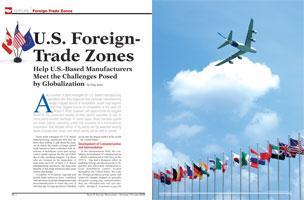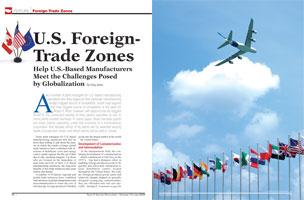

Ask a number of plant managers for U.S.-based manufacturing operations who they regard as their particular manufacturing facility’s biggest source of competition. Some may respond that their biggest source of competition is the plant for Brand X. Most, however, will respond that the biggest threat to the continued viability of their plant’s operation is one or more plants located overseas. In many cases, these overseas plants are sister plants operating under the umbrella of a multinational corporation that decides which of its plants will be awarded varying levels of production share, and which plants will be sold or closed.
Some plant managers for U.S.-based manufacturing operations will also be more than willing to talk about the manner in which the results of larger global trade initiatives have combined with increases in healthcare costs and energy costs to nearly squeeze the life out of their day-to-day operating margins. For those who are focused on the immediate or near-term survival of their U.S.-based manufacturing operations, the long-term benefits of free trade initiatives may seem remote and distant.
A number of bilateral, regional and global trade initiatives have combined with advances in global transportation and telecommunication to lower the cost of introducing foreign-produced finished goods into the largest market in the world – the United States.
Development of Containerization and Intermodalism
In the transportation field, the continuing development of containerization – which commenced in full force in the 1970’s – has had a dramatic effect in enabling foreign-produced goods to be quickly and efficiently transported to local distribution centers located throughout the United States. Not only are foreign-produced goods easily and relatively cheaply shipped on specially designed oceangoing containerships, they are offloaded onto rail cars specially designed for “stacktrain” shipment which enables two containers to ride on one railcar, one stacked on top of the other, and subsequently processed through inland intermodal centers where the goods are transferred to domestic, over-the-road trucks which deliver them to the doorstep of a domestic distribution facility.
Falling Tariff Rates
During the same timeframe as the development of containerization and intermodalism, U.S. tariff rates that apply to imported goods have fallen significantly, with many new products now eligible for duty-free importation into the United States. In 1970, roughly 65 percent of total U.S. import value consisted of dutiable products, with Customs duties comprising 6.5 percent of the total value of all imports. By contrast, figures for 2005 indicate that only 30 percent of total U.S. import value consisted of dutiable products, with Customs duties comprising only 1.4 percent of the total value of all imports.[1] The impetus for the fall in the effective tariff rates that apply to products imported into the U.S. can be easily identified. Multilateral tariff reductions such as the Tokyo Round of GATT and the Uruguay Round Agreements, and regional and bilateral trade initiatives such as the Generalized System of Preferences (GSP), the Caribbean Basin Economic Recovery Act (CBI), the U.S.-Israel Free Trade Area Agreement, the North American Free Trade Agreement (NAFTA) and the Andean Trade Preference Act have all contributed to the lowering of tariff barriers into the U.S. market.
In what might seem to appear to be a counterintuitive development (given the significant fall in U.S. tariff rates), the use of the U.S. Foreign-Trade Zones program has grown significantly since the 1970s. In 1970 there were eight U.S. Foreign-Trade Zone projects in the United States. Included within these Zone projects were a total of three special-purpose subzones. Today there are more than 160 active Zone projects with a total of more than 250 active special-purpose subzones. Total Zone-related manufacturing activity exceeds $400 billion annually.[2]
Rising Use of U.S. Foreign-Trade Zones
The reasons for the growth in the use of the U.S. Foreign-Trade Zones program during the same timeframe in which U.S. duty rates have fallen are twofold.
Duty rate reductions on imports into the U.S. have been accompanied by duty rate reductions by our trading partners. This has increased export opportunities for U.S-based manufacturers. However, duty rate reductions on imports into the U.S. have also created downward pressures on the operating margins of U.S.-based manufacturers as they compete for market or production share with their foreign-based counterparts.
In addition, the U.S. Foreign-Trade Zones program offers the unique ability to rationalize what would otherwise be irrational duty rate relationships between the Customs duty rates that apply to imported materials and components versus the rates that apply to imported finished products into which those materials and components may be incorporated. These irrational duty rate relationships are sometimes referred to as “inverted tariffs.”
In a number of “Free Trade Zones” in other countries – particularly those in developing countries – the sole benefit is the avoidance of internal customs duties on products that are re-exported from the Zone. In some instances U.S. Foreign-Trade Zones enable companies to reduce or eliminate duties on products produced for domestic consumption. This “tariff rate rationalization” benefit is a key distinction between the U.S. Foreign-Trade Zones program and many other free zone or customs duty regimes. Use of the U.S. Foreign-Trade Zones program for the purpose of obtaining relief from inverted tariffs offers a number of U.S.-based manufacturers an economically viable alternative to outsourcing their manufacturing operations to foreign locations.
A good example of the manner in which the U.S. Foreign-Trade Zones program can provide relief from irrational duty rate structures created by larger trade initiatives can be found in the aerospace manufacturing sector. Before describing how the U.S. Foreign-Trade Zones program provides a solution to the problem, the problem and its origins must be understood.
As previously noted, U.S. tariff rates have fallen as a result of several rounds of multilateral tariff agreements. Tariff reductions of the Uruguay Round Agreement, which commenced in 1995, were implemented in a number of strategic industries, including the aerospace industry. Because of the Uruguay Round tariff regime, a broad range of aerospace products, including satellites and space launch vehicles, are traded duty-free among a number of countries. This duty-free tariff regime has created new export opportunities for U.S.-based aerospace manufacturers; however, it has also brought on new financial pressures to “outsource” the manufacture of certain aerospace products to offshore locations. The reason for this is straightforward – in a number of cases, a given finished product may be imported into the U.S. at a “Free” rate of duty, but one or more of that product’s key raw materials remain subject to U.S. Customs duties under the current tariff structure of the United States.
For a U.S.-based subsidiary of a multinational high-tech company that produces major airframe structures for space launch vehicles for the U.S. marketplace, its competition is easy to identify: It’s the facility’s overseas “sister” plants. Under the United States’ pre-Uruguay Round tariff structure, the U.S. plant enjoyed a 3.7 percent rate of tariff protection against imports of competing products. Thus, for its multinational parent, it made economic sense to manufacture the airframe structures in the United States.
Today, because of the Uruguay Round of tariff reductions, the same airframe structures can be imported into the U.S. free of Customs duty. Unfortunately for the U.S.-based producer, the imported plastic resins that are used to produce the airframe structures are dutiable at 3.7 percent of their value – the same duty rate that applied to the resins before the Uruguay Round of tariff reductions. Other imported components and materials are dutiable at rates that range from 2 to 4 percent – the same duty rates that applied to them before the Uruguay Round of tariff reductions. If the imported components and materials represent 30 percent of the cost-of-production for the complete airframe structures, then the U.S. tariff structure imposes an overall addition of 1 percent to the cost of manufacturing the airframe structures in the U.S. versus overseas. In the absence of a means to restore a rational duty rate relationship between the company’s imported components versus its finished products, the reduced operating margins imposed by the inverted tariff structure would induce the multinational parent to shift its manufacture of the airframe structures to a foreign location.
Now for the Solution…
The means for restoring the rational duty rate relationship between the raw materials and the airframe structures is the use and implementation of U.S. Foreign-Trade Zones procedures. Upon application to, and approval by, the U.S. Foreign-Trade Zones Board, and upon approval of activation by U.S. Customs and Border Protection, the company can bring the imported components and materials into its Foreign-Trade Zone facility without paying Customs duty. The imported components and materials may then be used in the manufacture of the airframe structures. The complete airframe structures may then leave the FTZ production facility and be entered into the U.S. commerce at the same tariff rate that would apply to the finished products if they were manufactured overseas – that is, “Free.” This tariff rationalization feature of the U.S. Foreign-Trade Zones program enables the U.S.-based manufacturing operation to maintain the cost-of-production structure it needs in order to compete with its overseas sister plants.
Special-Purpose Subzones
Given the example above, one might ask, “Wouldn’t it be prohibitively expensive to move the plant to a Foreign-Trade Zone?” Indeed, it would be. However, for those facilities whose operations cannot be accommodated within an existing General-Purpose Zone, the local grantee of the Zone project can apply to have the existing operation designated as a “special-purpose subzone.” The application process is very similar to the process required to obtain FTZ manufacturing authority were the company already located within an existing Zone.
Even though special-purpose subzones are most often created to accommodate the ongoing operations of larger manufacturing operations, one should be aware that FTZ manufacturing authority is not reserved for larger manufacturers. In recent years the U.S. Foreign-Trade Zones Board has instituted important initiatives aimed at improving access to the Zones program for America’s small- and medium-sized businesses.
Temporary/Interim FTZ Manufacturing Authority
In August 2004 the Board adopted proposals which enable small- and medium-sized manufacturers already located within U.S. Foreign-Trade Zones to obtain temporary/interim FTZ manufacturing authority through what amounts to a fast-track application and review process. Under this initiative, a small- or medium-sized manufacturer already located within a Zone may, if it seeks to conduct manufacturing activities that have recently been approved for other Zone users in the U.S., apply for and be granted temporary/interim FTZ manufacturing authority in a matter of weeks. In some cases, this enables the small- or medium-sized manufacturer respond to a one-time contract opportunity which, if not for the economics provided by FTZ status, might otherwise be lost to a foreign-based manufacturing operation. In other cases, temporary/interim FTZ manufacturing authority may enable a small-or medium-sized manufacturer to initiate its FTZ manufacturing operation and enjoy Zone savings during the timeframe in which its application for permanent FTZ manufacturing authority is being processed under the FTZ Board’s normal review process.
In addition to the delegation of limited authority to the Board's Executive Secretary for decision-making on certain requests for manufacturing authority, the initiative provides for enhancements to the Board's pre-application procedures for small- and medium-sized manufacturers. In September 2006, the Foreign-Trade Zones Board adopted improvements to the temporary/interim FTZ manufacturing authority initiative which now broaden the eligibility requirements for potential applicants. Since the commencement of the initiative, 16 of our nation’s manufacturers have obtained temporary/interim FTZ manufacturing authority in order to enhance their international competiveness.
Use of the U.S. Foreign-Trade Zones Program
Today, the U.S. Foreign-Trade Zones program is used by a variety of America’s manufacturing industries, including manufacturers of electronics, computers, video and telecommunications equipment, plastics, food products, power tools and lawn care products, electronic business equipment, industrial and agricultural machinery, construction equipment, large and small appliances, climate control equipment, medical equipment, chemicals and petrochemicals, automobiles and auto parts, pharmaceuticals, ships, and sporting goods.
In an ever-increasing number of cases, Zone status enables U.S.-based businesses to enhance their bottom line, and, more importantly, maintain their value-added economic activity here in the United States.
[1] Source: U.S. International Trade Commission Web Database.
[2] Source: 68th Annual Report of the Foreign-Trade Zones Board to the Congress of the United States.

